
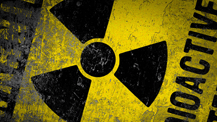
FUKUSHIMA NEWS
~ ~ ~ ~ ~ ~ ~
Help the
NO NUKES Y'ALL
campaign
y'all
Nuclear Watch South is a 501(c)(3) tax-deductible charitable organization.
{ thanks }
PayPal
It's your
safe and secure
way to donate on-line
 |
~ ~ ~ ~ ~ ~ ~
LISTEN TO
"UGLY NUKES CONTEST" PRESS CONFERENCE

~ ~ ~ ~ ~ ~ ~
NEW NUKES for Georgia???

NO THANKS!!!
CLICK HERE
~ ~ ~ ~ ~ ~ ~
THE ECONOMICS OF NUCLEAR REACTORS:
RENAISSANCE OR RELAPSE?
by Dr. Mark Cooper
Read the synopsis
MASSIVE SUBSIDIES WON'T SOLVE CLIMATE CHANGE
by Peter Bradford
"Florida Power and Light Billion-Dollar
Rate Hike Denied"
Salem News
"Leaks Imperil
Nuclear Industry"
The Boston Globe

Educating and activating the grassroots to create a
nuclear-free future
~
PO Box 8574
Atlanta, GA 31106
404-378-4263
Cell 404-432-8727
info@nonukesyall.org
NO NUKES Y'ALL!
NUCLEAR WATCH SOUTH | UGLY REACTORS CONTEST
“Ugly” field of four bailout candidates present huge taxpayer risks with rising cost estimates, delays, flawed reactor designs, credit downgrades
THE WHOLE UGLY STORY: Billions for Nuclear Bailouts and Tax-funded Loan Guarantees
WASHINGTON, D.C. (2/3/10) What if the federal government held a beauty contest for taxpayer-backed nuclear reactor loan guarantee bailouts … and no reactor project “beauties” could be lined up for the runway?
According to experts from around the United States, that is precisely the situation the U.S. Department of Energy (DOE) faces today with the extraordinarily weak crop of four reactor project candidates vying for loan-guarantee bailouts. The four proposed projects at the top of the list for $18.5 billion in federal bailout support are: the Southern Company’s Vogtle reactors in Georgia (the current front runner); the NRG reactor project in Texas; the VC Summer reactors in South Carolina; and the Calvert Cliffs reactor in Maryland.
The local experts are far from being alone in their negative assessment of the viability of the four bailout candidates. According to the independent Taxpayers for Common Sense, the four finalists all exhibit some combination of “rising cost estimates, delays related to reactor designs, and credit downgrades.” Making matters even worse: The four deeply flawed reactor projects are reputed to be the best of the options available, which means that there are no viable candidates in the pipeline to justify the tripling to $54 billion in nuclear reactor bailouts proposed under the White House budget released this week.
This is the latest bad news for the setback-plagued nuclear power industry, which is coming off of one of its worst months ever in January 2010, including a major court room squabble between NRG and the City of San Antonio over a surprise $4 billion estimated cost increase for two proposed reactors in Texas; the rejection of $1 billion in rate increases by Florida regulators that has caused the two state utilities to announce a slowdown on their nuclear projects; and a growing scandal in Vermont over carcinogenic tritium leaks into the water supply that threaten to derail state approval of the extension of the Vermont Yankee reactor.
EXPERTS: No good candidates for current nuclear reactor loan guarantee bailout funds, much less tripled amount under Obama budget plan.
HOW "THE UGLIES" STACK UP WITH THE EXPERTS
GEORGIA | Southern Company at Vogtle (2 Westinghouse AP1000 reactors on the Savannah River)
 Sara Barczak, a program director with the Southern Alliance for Clean Energy, addressing the proposed Vogtle reactors in Georgia, says, “It is difficult to fathom how the Vogtle project, which was a poster child for cost overruns in the original nuclear ‘boom’ and bust in the United States, could be the front runner for taxpayer-backed loan guarantee bailouts. Vogtle’s proposed Westinghouse AP1000 reactor design is not even approved by the Nuclear Regulatory Commission as safe from hurricanes, tornadoes and earthquakes. In fact, even if Vogtle got the loan guarantee go-ahead tomorrow, it could still face years of costly delays in order to make the reactor design safe or to gain license approval. This situation puts taxpayers squarely behind the eight ball in terms of increased risk from the very outset.
Sara Barczak, a program director with the Southern Alliance for Clean Energy, addressing the proposed Vogtle reactors in Georgia, says, “It is difficult to fathom how the Vogtle project, which was a poster child for cost overruns in the original nuclear ‘boom’ and bust in the United States, could be the front runner for taxpayer-backed loan guarantee bailouts. Vogtle’s proposed Westinghouse AP1000 reactor design is not even approved by the Nuclear Regulatory Commission as safe from hurricanes, tornadoes and earthquakes. In fact, even if Vogtle got the loan guarantee go-ahead tomorrow, it could still face years of costly delays in order to make the reactor design safe or to gain license approval. This situation puts taxpayers squarely behind the eight ball in terms of increased risk from the very outset.
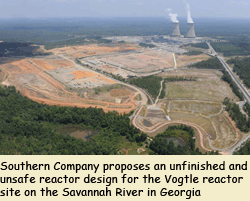 “The bottom line here is that extremely powerful and financially savvy utilities, such as the Southern Company, have already found a way at the state level to shift the risk to those who can least afford to pay for costly new reactors and now they're hoping for even more handouts -- this time at the expense of the U.S. taxpayer. How much more burden can be piled on to the shoulders of hard working families and small businesses in Georgia?”
“The bottom line here is that extremely powerful and financially savvy utilities, such as the Southern Company, have already found a way at the state level to shift the risk to those who can least afford to pay for costly new reactors and now they're hoping for even more handouts -- this time at the expense of the U.S. taxpayer. How much more burden can be piled on to the shoulders of hard working families and small businesses in Georgia?”
TEXAS | NRG at South Texas Project (2 General Electric ABWR reactors on the Gulf of Mexico)
 Karen Hadden, executive director of the Sustainable Energy and Economic Development (SEED) Coalition, addressing the embattled NRG reactor project in Texas, says: “The fact that NRG’s South Texas Project is considered a leading candidate for loan guarantees shows just how flawed the selection process is. This project may very well be doomed at this point, given the enormous recent cost increase of $4 billion that was kept from the San Antonio City Council, and the resulting legal wrangling between the utilities proposing to build the project.
Karen Hadden, executive director of the Sustainable Energy and Economic Development (SEED) Coalition, addressing the embattled NRG reactor project in Texas, says: “The fact that NRG’s South Texas Project is considered a leading candidate for loan guarantees shows just how flawed the selection process is. This project may very well be doomed at this point, given the enormous recent cost increase of $4 billion that was kept from the San Antonio City Council, and the resulting legal wrangling between the utilities proposing to build the project.
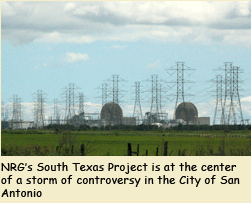 “The South Texas Project is a perfect example of how the hope of loan guarantees is the only thing propping up reactors that otherwise would not be built. Even with the loan guarantees, the San Antonio City Council has signaled to their municipal utility that ratepayers can’t afford the increasingly expensive energy from the reactor. NRG said they would not proceed with the reactor without the loan guarantees. If anyone can explain why sinking billions of taxpayer dollars into such a risky project makes any sense at all, it would be interesting to hear it!”
“The South Texas Project is a perfect example of how the hope of loan guarantees is the only thing propping up reactors that otherwise would not be built. Even with the loan guarantees, the San Antonio City Council has signaled to their municipal utility that ratepayers can’t afford the increasingly expensive energy from the reactor. NRG said they would not proceed with the reactor without the loan guarantees. If anyone can explain why sinking billions of taxpayer dollars into such a risky project makes any sense at all, it would be interesting to hear it!”
SOUTH CAROLINA | SCANA/SCG&E at Summer (2 Westinghouse AP1000 reactors on the Monticello Reservoir)
 Tom Clements, Friends of the Earth, addressing the proposed VC Summer reactors in South Carolina, says, “The VC Summer project is ripe for major delays and huge cost overruns. The NRC has confirmed that the AP1000 reactor design as currently being reviewed is not ‘certified’ safe, contrary to claims by the utility SCE&G. Key reactor components, including the reactor pressure vessel, will have to be made overseas, and 90 percent of the uranium for fuel would come from foreign sources, belying the notion of ‘home-grown power,’ as is now incorrectly being touted by some SC politicians. The approval by the South Carolina Public Service Commission (PSC) for the project in February 2009 and the law forcing ratepayers to pay in advance (even if the project fails) is being challenged by Friends of the Earth before the SC Supreme Court, with a hearing likely in March 2010.
Tom Clements, Friends of the Earth, addressing the proposed VC Summer reactors in South Carolina, says, “The VC Summer project is ripe for major delays and huge cost overruns. The NRC has confirmed that the AP1000 reactor design as currently being reviewed is not ‘certified’ safe, contrary to claims by the utility SCE&G. Key reactor components, including the reactor pressure vessel, will have to be made overseas, and 90 percent of the uranium for fuel would come from foreign sources, belying the notion of ‘home-grown power,’ as is now incorrectly being touted by some SC politicians. The approval by the South Carolina Public Service Commission (PSC) for the project in February 2009 and the law forcing ratepayers to pay in advance (even if the project fails) is being challenged by Friends of the Earth before the SC Supreme Court, with a hearing likely in March 2010.
 “SCE&G, which is a small utility with limited assets, has low-balled the reactor cost, still claiming that its 55 percent share of two units would include a gross construction cost of about $6.3 billion, for a total cost of about $11.5 billion for the two units, well below the estimated cost of other reactor projects. SCE&G has admitted in quarterly filings with the SC PSC that the cost had at one point increased $500 million. The PSC made it clear in a January 2010 ruling that, although it allowed an 18-month construction delay in its original decision, it will restart the delay clock every time SCE&G requests a new schedule for construction milestones. This, coupled with an almost-certain delay in issuance of a license by the NRC, is a warning sign that the project is facing great schedule and cost uncertainty.”
“SCE&G, which is a small utility with limited assets, has low-balled the reactor cost, still claiming that its 55 percent share of two units would include a gross construction cost of about $6.3 billion, for a total cost of about $11.5 billion for the two units, well below the estimated cost of other reactor projects. SCE&G has admitted in quarterly filings with the SC PSC that the cost had at one point increased $500 million. The PSC made it clear in a January 2010 ruling that, although it allowed an 18-month construction delay in its original decision, it will restart the delay clock every time SCE&G requests a new schedule for construction milestones. This, coupled with an almost-certain delay in issuance of a license by the NRC, is a warning sign that the project is facing great schedule and cost uncertainty.”
MARYLAND | Constellation at Calvert Cliffs (1 AREVA EPR reactor on the Chesapeake Bay)
 Michael Mariotte, executive director, Nuclear Information and Resource Service, addressing the proposed Calvert Cliffs reactor in Maryland, says, “The proposed EPR reactor at Calvert Cliffs is the most expensive reactor design ever put forward for the U.S. Constellation Energy admits costs of $10 billion (not including financing) for Calvert Cliffs, whereas PPL Electric Utility projects a cost of $13-15 billion, including financing, for an identical reactor in Pennsylvania. PPL’s estimate works out to approximately $9,000 per kilowatt—about double the cost of wind power along Maryland’s Atlantic coast.
Michael Mariotte, executive director, Nuclear Information and Resource Service, addressing the proposed Calvert Cliffs reactor in Maryland, says, “The proposed EPR reactor at Calvert Cliffs is the most expensive reactor design ever put forward for the U.S. Constellation Energy admits costs of $10 billion (not including financing) for Calvert Cliffs, whereas PPL Electric Utility projects a cost of $13-15 billion, including financing, for an identical reactor in Pennsylvania. PPL’s estimate works out to approximately $9,000 per kilowatt—about double the cost of wind power along Maryland’s Atlantic coast.
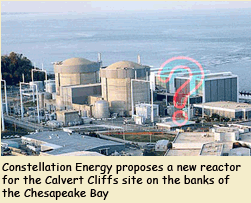 “Serious questions remain about the unprecedented level of foreign involvement in Calvert Cliffs. UniStar Nuclear is a 50/50 project of Constellation Energy and the French utility, Electricite de France (EdF). EdF is the largest single shareholder of Constellation (about 9 percent) and has recently purchased 49.9 percent of Constellation’s existing reactors. Most of the construction money will go to EPR manufacturer Areva. Both EdF and Areva are 85 percent or more owned by the French government. UniStar Nuclear hopes to complement the loan guarantee with financing from the French government’s Export-Import Bank. The NRC Commissioners have ordered that hearings on the foreign involvement issue be held before an Atomic Safety and Licensing Board. This foreign control is pertinent since Areva’s first EPR construction — Olikulioto-3 in Finland — is well over three years behind schedule and 75 percent over budget. The second EPR, being built by EdF at Flamanville, France, is at least 20 percent over budget after only two years of construction.”
“Serious questions remain about the unprecedented level of foreign involvement in Calvert Cliffs. UniStar Nuclear is a 50/50 project of Constellation Energy and the French utility, Electricite de France (EdF). EdF is the largest single shareholder of Constellation (about 9 percent) and has recently purchased 49.9 percent of Constellation’s existing reactors. Most of the construction money will go to EPR manufacturer Areva. Both EdF and Areva are 85 percent or more owned by the French government. UniStar Nuclear hopes to complement the loan guarantee with financing from the French government’s Export-Import Bank. The NRC Commissioners have ordered that hearings on the foreign involvement issue be held before an Atomic Safety and Licensing Board. This foreign control is pertinent since Areva’s first EPR construction — Olikulioto-3 in Finland — is well over three years behind schedule and 75 percent over budget. The second EPR, being built by EdF at Flamanville, France, is at least 20 percent over budget after only two years of construction.”
"To the village square
we must carry the facts
of atomic energy.
From there must come America's voice."
ALBERT EINSTEIN
~~~~~~
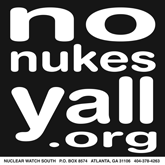
~~~~~~
BACKGROUND ON OPPOSITION TO NUCLEAR BAILOUTS
Widespread opposition has emerged to proposals to give previously authorized taxpayer-backed loan guarantee bailouts, as well as President Obama’s proposed $54 billion tripling of such bailouts.
Center for American Progress:
One down side of the president’s budget is that it includes a misguided expansion of nuclear loan guarantees. The Obama administration proposes to triple funds for nuclear loan guarantees from $18.5 billion to $54 billion. This huge growth exposes taxpayers to billions of dollars of potential liability if the nuclear debtors default on their loans.
The Congressional Budget Office found that nuclear investments are very risky, stating, "CBO considers the risk of default on such a loan guarantee to be very high — well above 50 percent."
Even if this risk factor is cut in half, one in four nuclear power plants would default on their loans due to cost overruns or other factors, leaving taxpayers to pick up the tab. And there are already indications that this could occur. Taxpayers for Common Sense found that none of the four “top-tier” project proposals for the existing loan guarantee program inspire confidence. All have “rising cost estimates, delays related to reactor designs, and credit downgrades.” The proposed tripling of the nuclear loan guarantee program burdens taxpayers with additional financial risk.
USA Today:
In a LETTER to Obama, four groups — the National Taxpayers Union, Taxpayers for Common Sense, the George Marshall Institute and the Non-Proliferation Policy Education Center — oppose an expansion of loan guarantees for new nuclear plants: "With hundreds of billions in bailouts already on the shoulders of U.S. taxpayers, the country cannot afford to move forward with a program that could easily become the black hole for hundreds of billions more."
Conservative Heritage Foundation's, David Kreutzer, a senior policy analyst in energy economic and climate change, warned against expanding loan guarantees: "This authorized $18.5 billion in loan guarantees will help build a handful of new nuclear reactors but any expansion of subsidies, tax credits or loan guarantees is a bad idea for taxpayers, consumers and long-term industry competitiveness. Continuing subsidies reduce the incentive to contain costs, create government dependence and stifle competition and technological development within the nuclear energy industry."
Economist Dr. Mark Cooper at the Institute for Energy and the Environment at Vermont Law School, authored a report in June that found it would cost $1.9 trillion to $4.1 trillion more over the life of 100 new nuclear reactors than it would to generate the same electricity from a combination of more energy efficiency and renewables.
Peter Bradford, former NRC Commissioner: "Of 26 new nuclear reactor license applications submitted to the Nuclear Regulatory Commission since 2007, nine have been canceled or suspended indefinitely in the last 10 months. Ten more have been delayed by one to five years. The Tennessee Valley Authority has canceled plans to revive a partially built unit.’”

